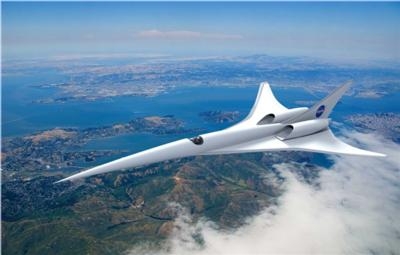Awarded 2-Year, $599,000 Program To Reduce Engine Noise During Takeoffs And Landings
Scientists at GE Global Research want to help enable future supersonic air travel by addressing existing challenges around engine noise. Global Research, which has a world-class team of research experts in acoustic, aerodynamic, fluidic, and combustion technologies, will explore new methods for reducing jet engine noise during takeoffs and landings of supersonic aircraft as part of a research project with NASA.

While achieving an acceptable sonic boom level is viewed as the key barrier to future supersonic overland flight, noise around airports during takeoff and landing of high speed aircraft would also be a challenge. Reducing noise is one of the research priorities of NASA’s vision to develop commercially viable supersonic transport.
“As a manufacturer of jet engines, wind turbines, and other powerful machines, we’re always looking for new and better ways to make them run as quietly as possible,” said Kishore Ramakrishnan, principal investigator on the NASA program and member of the Aerodynamics and Acoustics Lab at GE Global Research. “GE has developed extensive high fidelity simulation tools and design concepts for noise reduction in our commercial and military engines, and we now plan to leverage that technology to reduce propulsion noise for this application. We also are teaming with Lockheed Martin to understand the impact of these concepts on overall aircraft performance and sonic boom characteristics.”
With the retirement of the Concorde in 2003, supersonic air travel has ceased to exist in the commercial airline world. Supersonic speeds exceed the speed of sound at cruising altitudes, which is approximately 660 miles per hour (mph). Aircraft like the Concorde were capable of flying at twice the speed of sound. Today, a typical subsonic commercial flight at cruising altitudes flies in the 500-600 mph range.

The primary sources of aircraft noise affecting communities around airports are the engine and the aerodynamics of the aircraft itself as it flies through the air. As part of this research project, GE scientists will build upon past work with NASA and Lockheed Martin and focus on optimizing engine integration with the aircraft in addition to technologies to reduce fan and jet noise from the engine itself.
As one of the world’s leading manufacturer of aircraft engines, GE brings a deep level of experience and knowledge to aircraft engine design. GE scientists and engineers also have partnered with NASA at various times over many decades to support the development of next generation technologies for air and space travel.
“It’s truly amazing how far air travel has come over the past century. It has shrunk the world in ways we could not even have imagined 100 years ago,” said Narendra Joshi, Advanced Technology Program Leader for propulsion at GE Global Research. “We need to continue to push forward, and it is great that NASA is leading the way and supporting industry in developing the innovations that are needed to make economic supersonic air travel possible.”
(Top Image provided by GE Research. Bottom image provided by NASA)
 Classic Aero-TV: Remembering Bob Hoover
Classic Aero-TV: Remembering Bob Hoover ANN FAQ: Follow Us On Instagram!
ANN FAQ: Follow Us On Instagram! ANN's Daily Aero-Linx (05.15.24)
ANN's Daily Aero-Linx (05.15.24) ANN's Daily Aero-Term (05.15.24):Altimeter Setting
ANN's Daily Aero-Term (05.15.24):Altimeter Setting Aero-News: Quote of the Day (05.16.24)
Aero-News: Quote of the Day (05.16.24)




